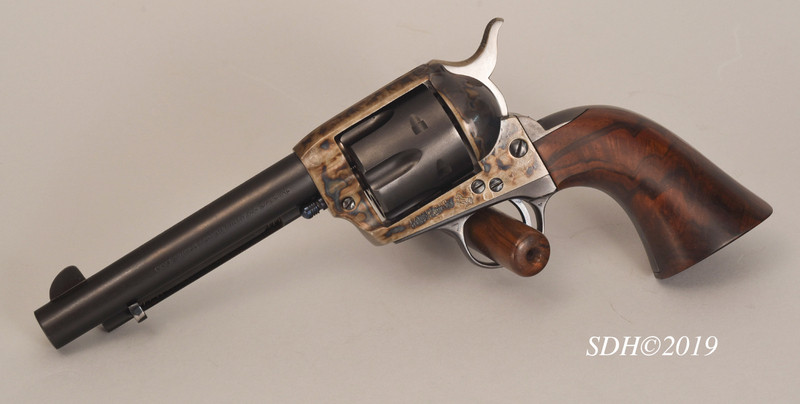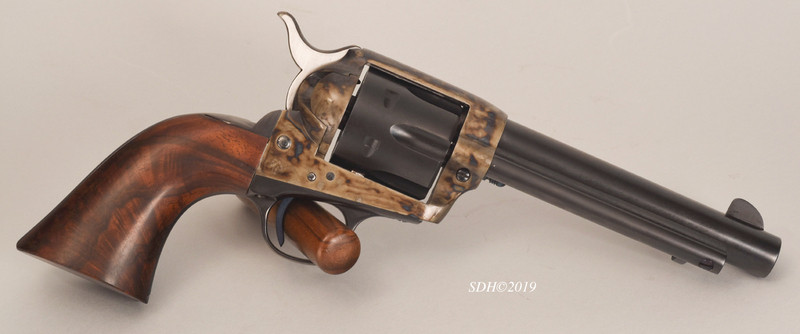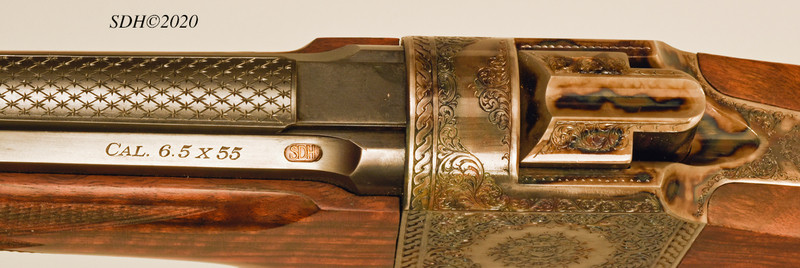|
S |
M |
T |
W |
T |
F |
S |
|
|
1
|
2
|
3
|
4
|
5
|
6
|
|
7
|
8
|
9
|
10
|
11
|
12
|
13
|
|
14
|
15
|
16
|
17
|
18
|
19
|
20
|
|
21
|
22
|
23
|
24
|
25
|
26
|
27
|
|
28
|
29
|
30
|
|
|
|
|
|
|
Forums10
Topics38,440
Posts544,755
Members14,404
| |
Most Online1,258
Mar 29th, 2024
|
|
|
|
Joined: Dec 2008
Posts: 277 Likes: 4
Sidelock
|

Sidelock
Joined: Dec 2008
Posts: 277 Likes: 4 |
Here�s my thoughts/suggestions:
When working up your CCH technique change only one variable.
Don�t �Practice� on a good guns; lots of cheap imported/semi-finished cast actions you can practice on.
Use fresh water each quench, goes back to changing only one variable. Each time you quench, it adds more �stuff� to the water, so in essence you�ve changed the composition of the water.
Don�t reuse the bone/wood char mix; at least not at first. Again goes back to: Change only one variable. Each time you quench the mix changes, especially if you�ve tried different ratios.
Everyone talks about cleanliness when rust bluing, cleanliness when CCH is even more important. Winchester would boil the parts in Gasoline� I asked OSHA about that, they had a fit. Your parts need to be clean, oil and water free, as an example, my cleaning procedure is a 4 step process.
Take detailed copious notes i.e... Wood/bone ratio, quench temp, soak time, water temp, O2 level in water etc. and then write down results.
When doing the above, don�t rely on a sample size of 1. Do at least 5 quenches exactly the same way so you get an average, then change one variable.
Remember, even if you do everything correctly, you may not get perfect results. I�ve had frames where one side is absolutely beautiful, and the other side has little or no color. Two frames quenched side by side, everything identical� one perfect� one less than perfect... it happens.
Also keep in mind there�s only about 3-5% of these old guns that have retained 90-100% of their original CCH. A very small sample size that you, and everyone else is comparing your colors to. Also, don�t compare colors to DTs, mine or anyone else�s, that�s their colors�. I have a notebook of 100�s of original colors that I compare to.
Respectfully
Mike
|
|
|
|
|
Joined: Jul 2005
Posts: 2,398 Likes: 16
Sidelock
|

Sidelock
Joined: Jul 2005
Posts: 2,398 Likes: 16 |
In my experience Mike Hunter is doing some great CCH. He's done two for me. What Mike is telling you here is the "voice of experience". Whenever you determine that in life, especially on the internet, it is time to pay attention. A Colt SAA I restored with Mike's "subdued" CCH, appropriate for vintage Colts.   A recently completed Hagn action with "subdued" colors that I further backed off with mild abrasive to give a "used" look and better show the spectacular engraving. The top of the breech block is straight colors from Mike. I got the correct hardness I was looking for and the parts glide on each other!  
|
|
|
|
|
Joined: Jan 2002
Posts: 9,736 Likes: 97
Sidelock
|

Sidelock
Joined: Jan 2002
Posts: 9,736 Likes: 97 |
good discussion about the re hardening and recoloring process, so far...
so next, what about tempering back the metal after the hardening quench?
do you consider this a necessary step and if so, why?
Last edited by ed good; 05/15/20 08:20 AM.
keep it simple and keep it safe...
|
|
|
|
|
Joined: Dec 2008
Posts: 277 Likes: 4
Sidelock
|

Sidelock
Joined: Dec 2008
Posts: 277 Likes: 4 |
Stephen
Thanks for the plug� The Hagn came out nice; I generally steer folks away from CCH when they want a nicely engraved piece done, CCH will hide a lot of detail, but the Hagn was well executed.
Ed Good brings up a good point� no pun intended. As I stated before, the extreme temperature change induces a lot of stresses into the metal, it�s a reality, you�ve added carbon to the steel and quenched it in water; changing the temperature by over a thousand degrees in a fraction of a second. The steel has changed.
As quenched, the steel will have a lot of internal stress, you need to relieve them the best that you can, optimally this would mean heating to annealing temp�BUT that would negate the hardness and colors. So you have to compromise.
We all know that steel changes colors when heated, the first notable color change occurs around 400 deg f. With that said, I recommend staying below that temp. Winchester would boil their parts for a period of time then tumble dry in sawdust.
I know for many that it�s frustrating that I won�t get into details, but there are a few folks out there dong CCH now, some are doing it absolutely wrong� them I like, they keep business coming my way.
CCH is also an Art and a Science. Getting the hardness is purely science, simple formula, X temp at Y time will give you Z depth of hardness. This was well known by the practitioners over 100 years ago. Lots of charts/formulas in the old books, fortunately not much on Google, which means if you want the info you have to spend the time researching.
The Art is in the colors, some folks want subdued, others want bright bold with lots of blue, and some want reds/greens. It�s all achievable with just wood/bone ratio, quench temp, O2 saturation in water and water temp�..simple.
Respectfully
Mike Hunter
|
|
|
|
|
Joined: Feb 2009
Posts: 7,463 Likes: 212
Sidelock
|

Sidelock
Joined: Feb 2009
Posts: 7,463 Likes: 212 |
Hi Mike,
You mention O2 saturation of the water. If it's okay to ask in general, do you measure it with a device or do you use an aeration protocol?
Thanks for any thoughts, Craig
|
|
|
|
|
Joined: Dec 2008
Posts: 277 Likes: 4
Sidelock
|

Sidelock
Joined: Dec 2008
Posts: 277 Likes: 4 |
No, I don�t use an O2 monitor like some other suggest.
It�s a �step� process�as noted earlier my kilns are digitally controlled. So for example: I may heat the parts to 10,000 degrees for 5 hours, at the 5 hour point my kiln will drop the temp to quench temp say 6000 degrees, well we know that the charcoal is an excellent insulator, so I allow the crucible with parts to normalize to the new lower temp, figure about an hour, once it�s normalized I will turn on the air at a specific volume approximately 20 minutes prior to quench.
The cool piece is that my controllers have a settable alarm, so I can be machining a barrel or whatever, and it will beep, reminding me to turn on the air.
The air provides two purposes, the first, it aids in the formation of colors, but more importantly it circulates the water thus avoiding inconsistent cooling. Hot steel parts dumped in water will cause the water immediately touching the part to turn into steam, this could form steam pockets which will not cool the parts as well as the water. The air provides the circulation, maintaining a constant flow of cool water against the parts�all this in fractions of a second.
|
|
|
|
|
Joined: Jan 2002
Posts: 9,736 Likes: 97
Sidelock
|

Sidelock
Joined: Jan 2002
Posts: 9,736 Likes: 97 |
mike: with regard to double gun parts, are you suggesting that tempering at temps less than 400 degrees f will provide enough elasticity to the metal to keep it from cracking under the stress of firing?
keep it simple and keep it safe...
|
|
|
|
|
Joined: Feb 2009
Posts: 7,463 Likes: 212
Sidelock
|

Sidelock
Joined: Feb 2009
Posts: 7,463 Likes: 212 |
I do appreciate the thoughts Mike, and through this thread.
I picked up on your comment about the charcoal being a good insulator. A common observable practice is that during the quench, many build in some sort of delay between the oven and releasing the parts into the water. Often one can see that the the crucible is subtly losing heat by changing color.
There�s got to be many variables related to the size and thickness of the crucible and the volume/physical thickness of the charcoal layer around and between the parts. Even the oven soak and temperature stabilizing must vary between equipment and users.
Do you have any thoughts on if the apparent drop in temperature of the crucible during a delay in quench translates to some lesser temperature of the parts than the last stabilized oven temperature? I�ve always been curious if there was any intention to have variable temperature across a single part, say slight cooling affects thinner areas with less mass first, with the possible hope of affecting color and distribution?
I know your time is valuable, I do appreciate your thoughts, Craig
|
|
|
|
|
Joined: Feb 2009
Posts: 7,463 Likes: 212
Sidelock
|

Sidelock
Joined: Feb 2009
Posts: 7,463 Likes: 212 |
mike: with regard to double gun parts, are you suggesting that tempering at temps less than 400 degrees f will provide enough elasticity to the metal to keep it from cracking under the stress of firing? Are you asking about the �case�?
|
|
|
|
|
Joined: Jan 2002
Posts: 9,736 Likes: 97
Sidelock
|

Sidelock
Joined: Jan 2002
Posts: 9,736 Likes: 97 |
please define case?
Last edited by ed good; 05/15/20 10:43 AM.
keep it simple and keep it safe...
|
|
|
|
|